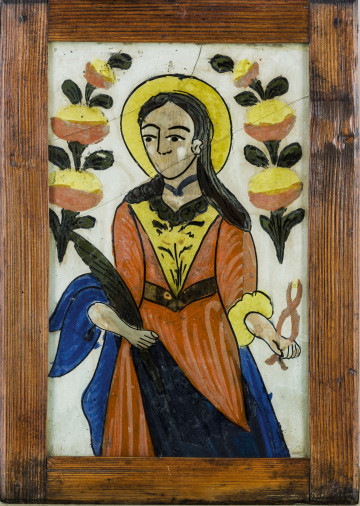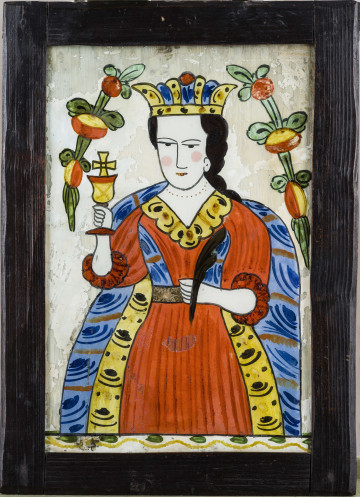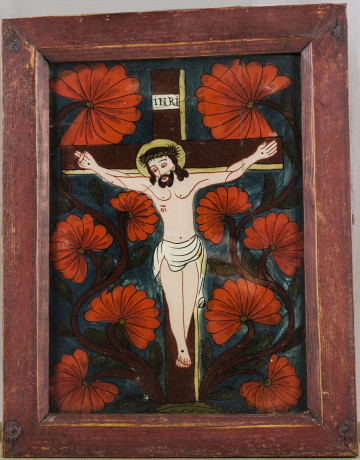
Saint Apolonia
1801 — 1900
National Museum in Lublin
Part of the collection: Folk Art of the Lublin Region (17th–1st half of the 20th c.)
The colours of old paintings on glass are very characteristic. As a rule, paints were not mixed much and colours were simplified. They were painted with pure colours, often contrasting them. Red, blue in all its shades, white, green and yellow were commonly used. In some paintings the colour gold appears. The colour was used to cover the nimbuses around the heads of saints and objects associated with precious metal, such as chalices, crowns and scepters. The effect of a golden gleam was achieved by putting glass, foil or, more rarely, gold flakes under unpainted or varnished glass. The backgrounds of paintings were painted in different colours, depending on the variety and workshop. The most common colours were navy blue, blue and creamy yellow.
Hand rubbed pigments were used for painting on glass and the binding agents were usually oil and linseed varnish. In most paintings the contours were made with water-based paints hardened with glue or rubber. In the gilded fragments laser paints with an increased admixture of oil and turpentine were often used. When drawing the outline, the artist was usually used underlays, which could be specially prepared patterns on paper or copper or woodcuts. The glass surface was thoroughly cleaned of greasy impurities before painting. This prevented the paint from chipping, even though the surface was wavy and full of air bubbles. The unintentional flaws increased the value of the paintings themselves, the light was refracted irregularly and created additional visual effects by means of reflections.
The technique of creating paintings on glass differed from that of painting on other surfaces: canvas, board or sheet metal. Contours, ornaments and details were painted first. After the first layer dried, the colour was applied to the surfaces within the contours, and finally to the background. The paint was applied in many ways: in spots, in lines and in spots. In the technique of painting on glass, when it was not possible to obtain effects by applying shades and textures, shading was replaced by the system of rhythmic thin lines accentuating the folds of the robe, the arrangement of hair or the richness of the floral decoration. This procedure, called graffiti, created the illusion of depth and divided larger planes of colour.
Author / creator
Dimensions
cały obiekt: height: 31,5 cm, width: 40,5 cm
Object type
picture
Material
glass, oil-based paint
Creation time / dating
Creation / finding place
Owner
The National Museum in Lublin
Identification number
Location / status

1801 — 1900
National Museum in Lublin

1801 — 1900
National Museum in Lublin

1801 — 1900
National Museum in Lublin
DISCOVER this TOPIC
National Museum in Lublin
DISCOVER this PATH
Educational path